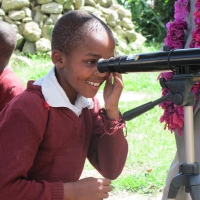- Created: Wednesday, October 01 2014 16:41
 The future of children's science education in Tanzania
The future of children's science education in Tanzania
is looking brighter than ever.
Our Indiegogo campaign was a great success, we made our goal thanks to some outstanding donations! Our founders, Sue and Chuck Ruehle were so estatic with the results that they had to put out a special thank you video.
To thank all of our donors who are helping make this project possible we have created a Thank You Wall.
We now have enough to build The Center for Science Education and Observatory and will become a reality in 2015. It will become a Tanzanian hub that will have a long-lasting impact nationwide by training teachers, offering hands-on laboratories (including an astronomical observatory), and providing quality educational resources.
The gateway to the development of Tanzania's own STEM curriculum has been opened, and the groundwork has been laid to begin the next critical phase of our campaign.
While running our Indiegogo campaign, we received a 12" telescope from Bill Pothen of the Racine Astronomical Society. This mid-sized scope will now be rehabilitated to brand-new condition and then taken with Sue and Chuck on their next trip, some time fall 2014.
We are now looking forward to expanding our efforts in Tanzania. With our new Stretch Goals we would like to raise $17,000 more. This will enable us to DOUBLE the number of astronomy/science ambassadors who will:
- Visit schools throughout Tanzania
- Train teachers to teach hands-on, inquiry-based science
- Teach students
- Train government education officers in understanding science teaching and scientific concepts
- Bring more NEW science curricula to schools throughout Tanzania
- Provide science education resources to TWICE as many schools
This stretch goal will allow Telescopes to Tanzania to visit an ADDITIONAL 30 schools, train an ADDITIONAL 60 teachers, and directly reach an ADDITIONAL 2000 students.
The cost for each new ambassador includes a one-week hands-on training program, a resource package used for their training sessions including a telescope and teaching materials, 10 visits to schools through the year (including transportation), and resources to be left in each classroom that's visited.
This is the BEST way to build on this ongoing effort, to expand what has already created, and to share the gains to be made. The greater the reach, the more the government and other in-country stakeholders will take note and provide assistance. Early success will show it CAN and WILL happen.







